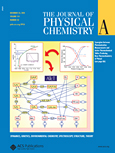
The Heats of Formation of C6H5, C6H5+, and C6H5NO by TPEPICO and Active Thermochemical Tables Analysis
William R. Stevens,a Branko Ruscic,b,c and Tomas Baera
a Department of Chemistry, University of North Carolina, Chapel Hill, North Carolina 27517, United States
b Chemical Sciences and Engineering Division, Argonne National Laboratory, Argonne, Illinois 60439, United States
c Computation Institute, University of Chicago, Chicago, Illinois 60637, United States
J. Phys. Chem. A
114(50), 13134�13145 (2010)

Threshold photoelectron photoion coincidence has been used to prepare selected internal energy distributions
of nitrosobenzene ions [C6H5NO+].
Dissociation to C6H5+ + NO products was measured over a range of internal
energies and rate constants from 103 to 107 s-1 and fitted with the
statistical theory of unimolecular decay. A 0 K dissociative photoionization onset energy of 10.607 � 0.020 eV
was derived by using the simplified statistical adiabatic channel model.
The thermochemical network of Active Thermochemical Tables (ATcT) was expanded to include phenyl and phenylium,
as well as nitrosobenzene. The current ATcT heats of formation of these three species at 0 K (298.15 K) are
350.6 (337.3) � 0.6, 1148.7 (1136.8) � 1.0, and 215.6 (198.6) � 1.5 kJ mol-1, respectively.
The resulting adiabatic ionization energy of phenyl is 8.272 � 0.010 eV. The new ATcT thermochemistry for phenyl
entails a 0 K (298.15 K) C-H bond dissociation enthalpy of benzene of 465.9 (472.1) � 0.6 kJ mol-1.
Several related thermochemical quantities from ATcT, including the current enthalpies of formation of benzene,
monohalobenzenes, and their ions, as well as interim ATcT values for the constituent atoms, are also given.




 comment:
comment:
